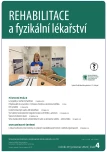-
Medical journals
- Career
Relaxation of shortened muscles in children by scootering
Authors: Třískala Z. 1; Bičíková M. 2; Máčová L. 2; Hill M. 2; Jandová D. 3; Morávek O. 3; Musílek M. 4; Wurstová I. 4; Škvařilová V. 4; Filó L. 5; Jurčáková E. 5; Kalina M. 5; Buchtová P. 5
Authors‘ workplace: Lékařská fakulta v Plzni, Univerzita Karlova 1; Endokrinologický ústav, Praha 2; MediCentrum JONA s. r. o., Praha 3; Státní léčebné lázně Bludov, s. p. 4; Priessnitzovy léčebné lázně a. s., Jeseník 5
Published in: Rehabil. fyz. Lék., 29, 2022, No. 4, pp. 181-193.
Category: Original Papers
doi: https://doi.org/10.48095/ccrhfl2022181Comparison of the results, i.e. the number and severity of findings of shortened muscles by the test according to Janda and the CK test – Medi Complex software – level for healthcare
Overview
The aim of this part of the pilot study of basic research is to objectify the results of the effect of complex spa and rehabilitation treatment with and without added kick scooter riding on the changes in the length of selected skeletal muscles of younger school children (6–12 years). Two different methods were used for objectification: examination by Janda’s tests and examination by the Computer Kinesiology (CK) system. The authors present the summary results from a two-year study (2020 and 2021). The concordance of the results from both examinations for most tests provides the possibility to use only the CK system for further research. Monitoring of salivary cortisol levels was used as objective evidence of children’s reactivity to exercise. A pilot study, according to the rules of evidence-based medicine, objectively showed a positive effect of comprehensive spa and rehabilitation care on children’s movement behavior. Children with added kick scooter activity achieved better results. Statistical evaluation of correlation coefficients of changes in salivary cortisol levels showed no relationship with the observed parameter of muscle length change (stretch rate).
Keywords:
cortisol – children – shortened muscles – locomotor system – Computer Kinesiology – balneotherapy – kick scooter riding
Sources
1. Atkinson RL. Psychologie. Praha: Portál 2003.
2. Hošek V. Pohyb a kvalita života. In: Krejčí M, Hošek V et al. Wellness. 1. vyd. Praha: Grada Publishing 2016.
3. Cimolin V, Vismara L, Galli M et al. Effects of obesity and chronic low back pain on gait.
J Neuro Engineering Rehabil 2011; 8 : 1–7. doi: 10.1186/1743-0003-8-55.
4. Colné P, Frelut ML, Pérès G et al. Postural control in obese adolescents assessed by limits of stability and gain initiation. Gait Posture 2008; 28(1): 164–169. doi: 10.1016/j.gaitpost.2007.11.006.
5. Janda V. Základy kliniky funkčních (neparetických) hybných poruch. Brno: Ústav pro další vzdělávání středních zdravotnických pracovníků 1982 : 85–88.
6. Kolář P. Diferenciace svalové funkce z hlediska posturální podstaty. Med Sport Boh Slov1996; 1 : 4–8.
7. Lewit K. Zřetězení funkčních poruch pohybové soustavy. Čas Lék Čes1987; 4 : 1310–1312.
8. Lewit K. Funkční myšlení – funkční přístup. In: Lewit K. Manipulační léčba v myoskeletální medicíně. Praha: ČLS JEP 1996 : 139–140.
9. Lewit K. Vztah struktury a funkce v pohybové soustavě. Rehabil Fyz Lék 2000; 3 : 99–101.
10. Třískala Z et al. Vliv koloběhu na pohybový systém mladších školních dětí. Rehabil Fyz Lék 2021; 28(2): 67–74.
11. Anderson SE, Dallal GE, Must A. Relative weight and race influence average age at menarche: results from two nationally representative surveys of US girls studied 25 years apart. Pediatrics 2003; 111(4 Pt 1): 844–850. doi: 10.1542/peds.111.4.844.
12. Rob L, Martan A, Citterbart K et al. Gynekologie. 2. vyd. Praha: Galén 2008 : 97.
13. Gúth A. Vyšetrovacie metodiky v rehabilitácii pre fyzioterapeutov. Bratislava: Liečreh Gúth 2009 : 74–82.
14. Haladová E, Nechvátalová L. Vyšetřovací metody hybného systému. Brno: NCO NZO 2005.
15. Máček M, Radvanský J et al. Fyziologie a klinické aspekty pohybové aktivity. Praha: Galén 2011.
16. Jandova D. Existence expertních informačních systémů ve fyzioterapii. Rehabil Fyz Lék 2009; 16(4): 150–154.
17. Janda V et al. Svalové funkční testy. Praha: Grada Publishing 2004 : 311–328.
18. Kendall H, Kendall FP, Wadsworth GE et al. Muscles, testing and function. 2nd ed. Baltimore: Williams and Wilkins 1971.
19. Kendall H, Kendall E. Muskeln Funktionen und Test. Stuttgart: Urban and Fischer 1985.
20. Meloun M, Hill M, Militký J et al. New methodology of influential point detection in regression model building for the prediction of metabolic clearance rate of glucose. Clin Chem Lab Med 2004; 42(3): 311–322. doi: 10.1515/CCLM.2004.057.
21. Meloun M, Militký J, Hill M et al. Crucial problems in regression modelling and their solutions. Analyst 2002; 127(4): 433–450. doi: 10.1039/b110779h.
22. Trygg J, Wold S. Orthogonal projections to latent structure (O-PLS). J Chemometrics 2002; 16 : 119–128. doi: 10.1002/cem.695.
Labels
Physiotherapist, university degree Rehabilitation Sports medicine
Article was published inRehabilitation & Physical Medicine

2022 Issue 4-
All articles in this issue
- Laryngocele and possibilities of treatment
- Physical activity in patients with Crohn‘s disease and ulcerative colitis
- KISS syndrome
- Relaxation of shortened muscles in children by scootering
- The effect of musical sensorimotor integrative therapy on the speech of a child with autism
- Scale for the Assessment and Rating of Ataxia
- The effect of myofascial therapy of the suboccipital muscles on postural stability – a pilot study
- Fine motor skills assessment limitations in selected standardized tests – perspective of occupational therapists
- Rehabilitation & Physical Medicine
- Journal archive
- Current issue
- Online only
- About the journal
Most read in this issue- KISS syndrome
- Fine motor skills assessment limitations in selected standardized tests – perspective of occupational therapists
- Relaxation of shortened muscles in children by scootering
- Scale for the Assessment and Rating of Ataxia
Login#ADS_BOTTOM_SCRIPTS#Forgotten passwordEnter the email address that you registered with. We will send you instructions on how to set a new password.
- Career

